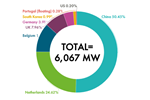Global Offshore Wind Report 2021 forecasts 235 GW installed over next decade
Though the forecasted new offshore wind capacity is seven times larger than the current market size, it’s only 2% of what’s needed for zero-emission targets, GWEC says.
This chart indicates offshore wind installations 2020-2030 globally. Photo Credit, all images: GWEC Market Intelligence, July 2021
On Sept. 9 the (GWEC, Brussel, Belgium) released the third edition of its annual flagship Global Offshore Wind Report. The report found that offshore wind capacity grew steadily in 2020, with 6.1 gigiwatts (GW) installed globally, but governments will need to act decisively to improve policy in order to scale up installations at the pace required to help the world meet its carbon emissions targets and avoid the worst effects of climate change. These conclusions are similar to GWEC’s last report in April).
Total offshore wind added between 2021-2030.
The report highlights offshore wind’s role in the decades ahead as one of the central planks of the world’s future energy system on the road to net zero, the latest technology innovations to open new opportunities for the sector and how the offshore wind industry is powering a green recovery and just transition.
GWEC points out these key highlights from the report:
- Led by China, the world installed 6.1 GW of offshore wind in 2020
- 2020 was the second highest year for offshore wind installations despite COVID-19 disruptions, following a record year in 2019
- Offshore wind has the biggest growth potential of any renewable energy technology but the policy environment needs to improve rapidly for offshore wind to reach international net-zero targets
- Offshore wind today is only 2% of what the world needs to get to net zero by 2050
- The report forecasts 235 GW of new offshore wind capacity will be installed over the next decade under current policies. That capacity is seven times bigger than the current market size, and is a 15% increase on the previous year’s forecasts
- A growing group of countries have identified offshore wind as a key technology for reaching climate targets, but governments now need to follow up on commitments and work with industry to allow investment to scale up rapidly.
Download the .
Related Content
-
Infinite Composites: Type V tanks for space, hydrogen, automotive and more
After a decade of proving its linerless, weight-saving composite tanks with NASA and more than 30 aerospace companies, this CryoSphere pioneer is scaling for growth in commercial space and sustainable transportation on Earth.
-
High-tension, vertical filament winding enables affordable flywheel energy storage system
French startup Energiestro’s prototype solar energy flywheel-based storage system aims to reduce costs with glass fiber composites and prestressed concrete.
-
Plant tour: Hexagon Purus, Kassel, Germany
Fully automated, Industry 4.0 line for hydrogen pressure vessels advances efficiency and versatility in small footprint for next-gen, sustainable composites production.



